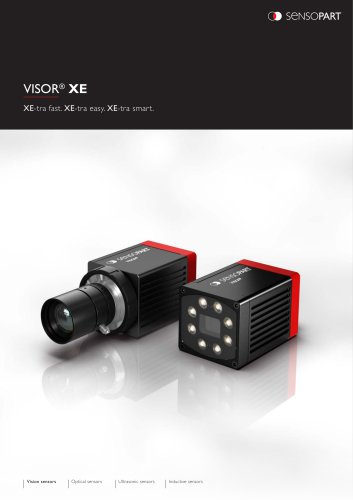 Website:
SensoPart Industriesensorik GmbH
Website:
SensoPart Industriesensorik GmbH
Catalog excerpts
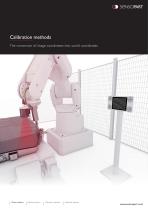
Calibration methods The conversion of image coordinates into world coordinates Vision sensors Optical sensors Ultrasonic sensors Inductive sensors
Open the catalog to page 1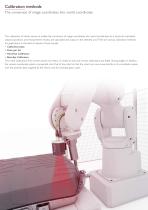
Calibration methods The conversion of image coordinates into world coordinates The calibration of robots serves to enable the conversion of image coordinates into world coordinates. As a result, all coordinate outputs (positions and measurement results) are calculated and output in the selected unit. There are various calibration methods for applications in the field of robotics. These include: ▪ Calibration plate ▪ Point pair list ▪ Hand-Eye Calibration ▪ Base-Eye Calibration The robot calibrations first convert pixels into metric or imperial units and correct distortions and tilted...
Open the catalog to page 2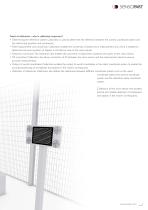
Goals of calibration - why is calibration important? ▪ Determining the reference system: Calibration is used to determine the reference between the camera coordinate system and the robot base (position and orientation). ▪ Pixel measurement unit conversion: Calibration enables the conversion of pixels into a measurement unit, which is needed to determine the exact position of objects in the field of view of the vision sensor. ▪ Distortion correction: The calibration also enables the correction of distortions caused by the optics of the vision sensor. ▪ Tilt correction: Calibration also...
Open the catalog to page 3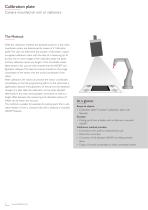
Calibration plate Camera mounted on arm or stationary The Method: With this calibration method, the absolute positions in the robot coordinate system are determined by means of a "calibration plate". The user can determine the position of the plate in space via applied reference marks with the help of a measuring tip. To do this, one or more images of the calibration plate are taken and four reference marks are taught in. The coordinate values determined in this way are then entered into the VISOR® configuration software. This teach-in process transforms the image coordinates of the sensor...
Open the catalog to page 4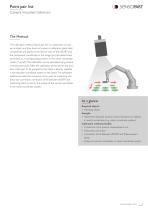
Point pair list Camera mounted stationary The Method: The calibration method "point pair list" is a calibration on the work object and thus does not require a calibration plate. Real components are placed in the field of view of the VISOR® and the component coordinates in the image (px) are determined and linked to a corresponding position in the robot coordinate system ("world"). The calibration can be calculated using several of these point pairs. After the calibration of the sensor, the position of the part to be gripped by the robot is directly available in the absolute coordinate...
Open the catalog to page 5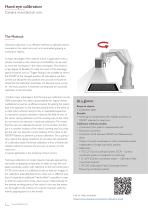
Hand-eye calibration Camera mounted on arm The Method: Hand-eye calibration" is an effective method to calibrate sensors mounted on the robot arm, such as in automated gripping or screwing of objects. A major advantage of this method is that in applications with a camera mounted on the robot arm, this flexibility can be used to move the workspace in the robot workspace. This results in a high degree of flexibility. To make the most of this advantage, special functions such as "Trigger Robotic" are available to inform the VISOR® of the changed position. All calculations are then carried out...
Open the catalog to page 6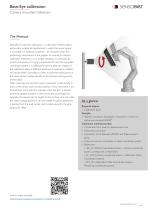
Base-Eye calibration Camera mounted stationary The Method: SensoPart's base-eye calibration is a calibration method that is particularly suitable for applications in which the vision sensor is mounted in a stationary position - for example, when fine positioning components in the gripper. In contrast to classical calibration methods, it is no longer necessary to manually approach real points or to grip components. To map the complete coordinate system, it is sufficient to take at least ten images of the calibration plate in different positions. If required, an additional "result offset" is...
Open the catalog to page 7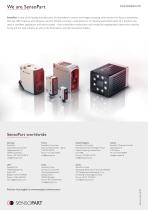
SensoPart is one of the leading manufacturers of photoelectric sensors and image processing vision sensors for factory automation. We also offer inductive and ultrasonic sensors, thereby covering a wide spectrum of industrial automation tasks. Our products are used in countless applications and sectors today – from automotive construction and mechanical engineering to electronics manufacturing and the solar industry, as well as the food sector and pharmaceutical industry. SensoPart worldwide France SensoPart France Sarl 662, rue des Jonchères – Bât. A F-69730 GENAY Phone +33 164 730061...
Open the catalog to page 8All SensoPart Industriesensorik GmbH catalogs and technical brochures
-
BlueLight - The NEW standard
12 Pages


